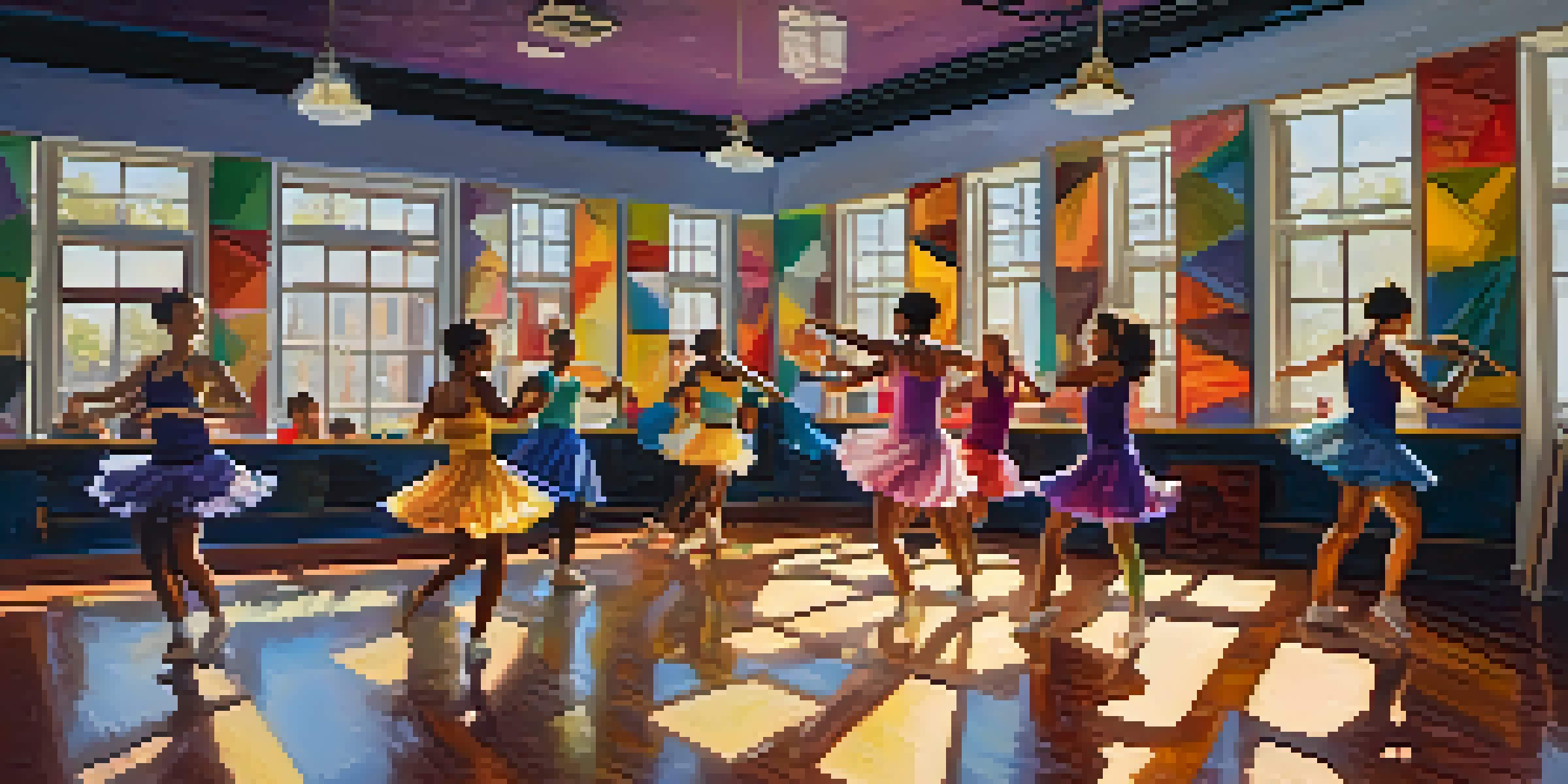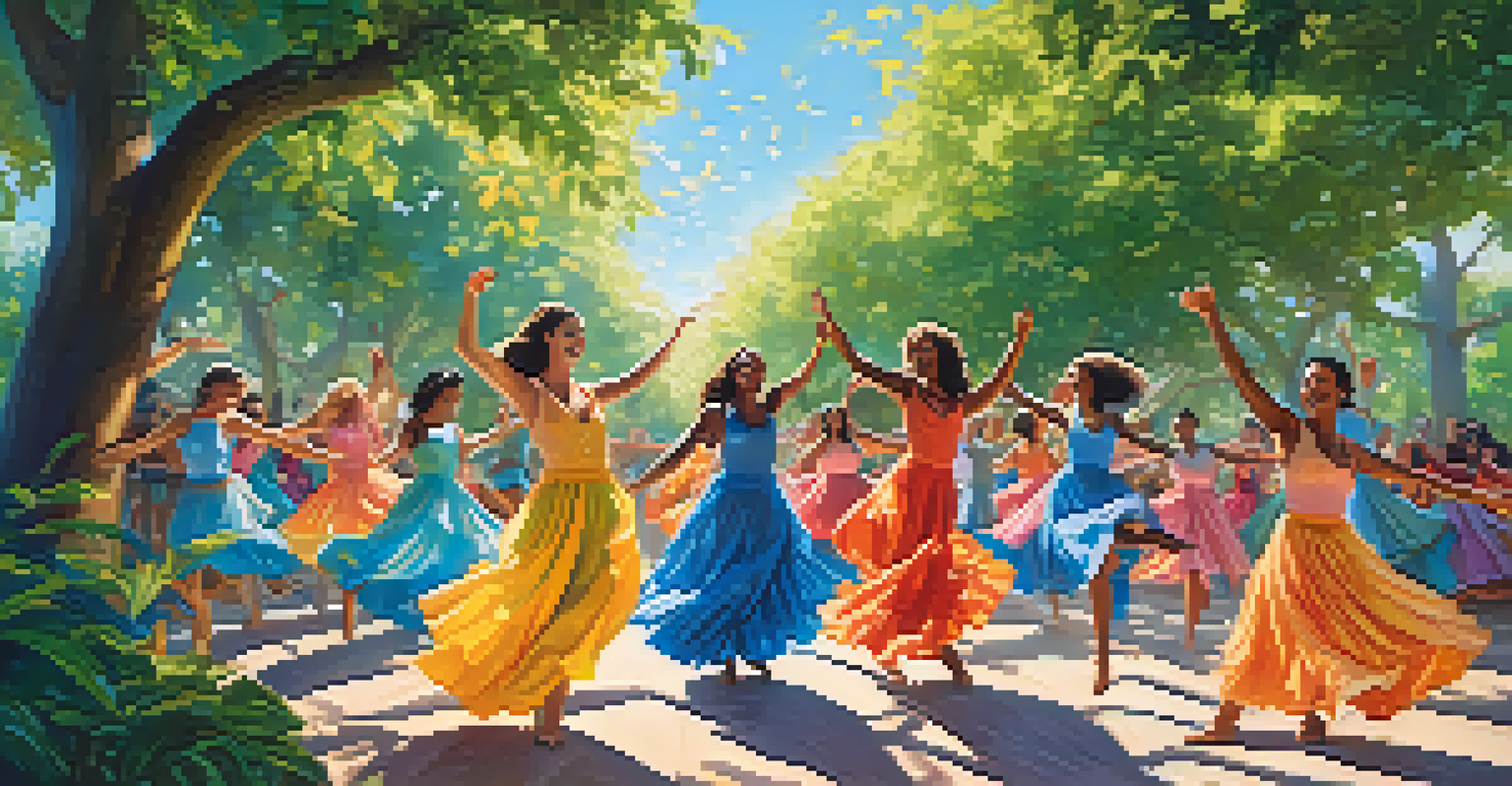Ukulele Beats in Contemporary Dance Choreography

The Rise of the Ukulele in Modern Music and Dance
The ukulele, once a humble instrument, has found its place in various music genres, making waves in contemporary dance. Its cheerful, bright sound adds a unique flavor to choreography, often evoking feelings of joy and freedom. As dance evolves, artists are increasingly embracing the ukulele for its versatility and accessibility, allowing for innovative rhythms and melodies that inspire movement.
The ukulele's cheerful sound can lift spirits and create an atmosphere of joy and celebration.
Incorporating ukulele beats into dance routines invites a fresh perspective, blending traditional sounds with contemporary styles. This fusion not only broadens the musical landscape for choreographers but also resonates with audiences who crave authenticity and creativity. The instrument's charming strumming patterns can complement various dance forms, from lyrical to hip-hop, creating a joyful atmosphere on stage.
Moreover, the rise of social media platforms has further popularized the ukulele, with viral videos showcasing its upbeat tunes. This accessibility encourages dancers to experiment with the instrument, leading to a surge in creative choreography that captivates viewers. The ukulele's rise in popularity is a testament to its ability to inspire and engage, shaping the future of dance.
Creating Unique Choreography with Ukulele Sounds
Choreographers are increasingly crafting routines that leverage the unique rhythms of ukulele music. The light, playful tones can serve as a perfect backdrop for storytelling in dance, allowing movements to reflect the carefree spirit of the instrument. By focusing on the ukulele’s distinct sound, artists can create a dialogue between the music and the dance, enhancing the overall performance.

For example, a choreographer might choreograph a piece that mimics the gentle strumming of the ukulele, with dancers moving in sync to the beat. This approach not only highlights the instrument but also enriches the audience's experience as they see the physical representation of the music. Such choreography encourages dancers to connect emotionally with the piece, resulting in a more engaging performance.
Ukulele's Joyful Influence on Dance
The ukulele's cheerful sound enhances choreography, inviting creativity and emotional connection in performances.
Additionally, using ukulele beats can inspire improvisation during rehearsals, allowing dancers to explore their movements more freely. This spontaneous creativity often leads to unexpected moments on stage, making performances feel fresh and alive. The ukulele's upbeat nature encourages a sense of playfulness, which can transform the way dance is conceived and performed.
The Emotional Impact of Ukulele Music in Dance
Ukulele music often evokes feelings of nostalgia and warmth, which can significantly enhance the emotional depth of a dance piece. Choreographers harness this emotional resonance, using it to connect with audiences on a personal level. When dancers embody the feelings that ukulele music evokes, it creates a powerful synergy between movement and melody.
Music, in its essence, is a form of communication, and dance is its visual counterpart.
For instance, a dance set to a soft ukulele ballad might explore themes of love or longing, with fluid movements that reflect the gentle strumming. The emotional connection forged through music can elevate a performance, making it more memorable. Audiences often leave performances feeling touched, as the combination of movement and music resonates deeply within them.
Moreover, the ukulele's cheerful sound can also inspire themes of joy and celebration. Dance pieces that center around upbeat ukulele tunes often invite audiences to share in the happiness of the performance, fostering a sense of community. This emotional impact is a vital aspect of contemporary choreography, as it encourages deeper connections between dancers and their viewers.
Collaboration Between Musicians and Dancers
The integration of ukulele music in contemporary dance often fosters collaboration between musicians and dancers. This partnership allows for a dynamic exchange of ideas, resulting in creative choreography that blurs the lines between music and movement. When dancers work closely with ukulele players, they can develop a unique synergy that enhances both the performance and the creative process.
For example, a choreographer might hold workshops with a ukulele musician to explore how different strumming patterns can influence movement. This collaborative approach can lead to innovative choreographic ideas, as dancers respond to the rhythms and melodies created live. Such interactions not only enrich the choreography but also create a more immersive experience for the audience.
Collaboration Fuels Creative Choreography
Partnerships between musicians and dancers foster innovative routines that merge music with movement.
These collaborations also expand the reach of both art forms, introducing audiences to the beauty of the ukulele alongside contemporary dance. By showcasing the unique talents of musicians and dancers, performances become a celebration of creativity and artistic expression. This growing trend of collaboration highlights the importance of community in the arts, encouraging artists to support and inspire one another.
Ukulele Beats in Dance Competitions
Ukulele beats are making a notable impact in dance competitions, where originality is key. Choreographers are increasingly selecting ukulele tracks to stand out from the crowd, adding a refreshing twist to their routines. This choice not only showcases the dancers' skills but also highlights their creativity in musical selection, often leaving a lasting impression on judges and audiences alike.
The playful nature of ukulele music allows for fun and engaging choreography that captivates viewers. Dancers often incorporate whimsical elements into their performances, using the upbeat tempo to enhance their energy and stage presence. This combination of creativity and enthusiasm can set a routine apart, making it more likely to be remembered during competitions.
Moreover, the ukulele's accessibility encourages a wider range of dancers to experiment with different styles and interpretations. This inclusivity fosters a sense of community among competitors, as they share their unique takes on the music. Ultimately, the use of ukulele beats in dance competitions amplifies the spirit of innovation and creativity that defines contemporary dance.
The Cultural Significance of the Ukulele in Dance
The ukulele is more than just a musical instrument; it carries cultural significance that enriches contemporary dance. Originating from Hawaii, the ukulele embodies the spirit of aloha, promoting a sense of joy and connection. By incorporating this instrument into dance, choreographers pay homage to its roots while also celebrating its evolution across different genres and cultures.
This cultural dimension adds depth to dance performances, as artists weave stories that reflect the ukulele's journey. For example, a choreographed piece might draw inspiration from Hawaiian traditions, incorporating elements of hula dance alongside the ukulele's melodic lines. Such fusion not only educates audiences about the instrument's history but also fosters appreciation for diverse cultural expressions.
Cultural Significance in Dance
Incorporating the ukulele enriches performances by celebrating its cultural roots and promoting unity in the arts.
Furthermore, the ukulele's global reach has made it a symbol of unity in the arts. As dancers and musicians from various backgrounds collaborate, they create a rich tapestry of movement and sound that transcends cultural boundaries. This celebration of diversity is essential in contemporary dance, as it reflects the interconnectedness of our modern world.
Future Trends: Ukulele in Dance and Performance
As we look to the future, the role of the ukulele in dance and performance seems poised for growth. With its increasing popularity, we can expect to see more choreographers experimenting with ukulele sounds to create innovative routines. This trend not only highlights the instrument's versatility but also encourages a new generation of artists to explore its potential in their work.
Moreover, advancements in technology may further enhance the collaboration between musicians and dancers. Imagine performances that integrate live-streaming or interactive elements, where audiences can engage with ukulele music in real-time. Such innovations could revolutionize the way we experience dance, making it more accessible and immersive.

Ultimately, the future of ukulele beats in contemporary dance choreography promises to be bright. As artists continue to push boundaries and explore new creative avenues, we can anticipate a vibrant fusion of music and movement that captivates audiences worldwide. The ukulele will undoubtedly remain a beloved instrument, inspiring countless performances for years to come.